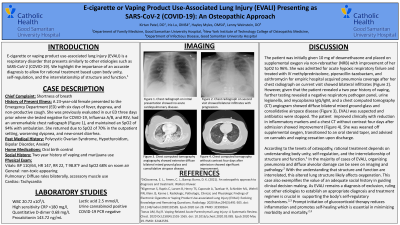Back

Clinical: General Topics
E-cigarette or Vaping Product Use-Associated Lung Injury (EVALI) Presenting as SARS-CoV-2 (COVID-19)
Friday, March 31, 2023
12:00 PM East Coast USA Time

- KP
Kirtan Patel, DO
Good Samaritan Hospital Medical Center
West Islip, New York, United States
Presenting Author(s)
Introduction: E-cigarette or vaping product use-associated lung injury (EVALI) is a respiratory disorder that presents similar to other etiologies such as SARS-CoV-2 (COVID-19). We present a case of EVALI to highlight the importance of an accurate diagnosis to allow for rational treatment based upon body unity, self-regulation, and the interrelationship of structure and function.
Case Study: A 23-year-old female presented to the Emergency Department (ED) with six days of fever, dyspnea, and non-productive cough. She was previously evaluated in our ED three days prior where she tested negative for COVID-19, Influenza A/B, and RSV, had an unremarkable chest radiograph (CXR), and maintained an SpO2 of 94% with ambulation. She returned due to SpO2 of 70% in the outpatient setting, worsening dyspnea, and new-onset diarrhea. Her vitals were BP 110/64, HR 147, RR 22, T 98.8°F and SpO2 68%, and she revealed a two year history of vaping and marijuana use. The patient was given 10 mg of dexamethasone and placed on supplemental oxygen via non-rebreather (NRB) with improvement of SpO2 to 96%. Laboratory findings included WBC 20.72 x109/L, high sensitivity CRP >180 mg/L, procalcitonin 143.72 ng/mL, lactic acid 2.5 mmol/L, quantitative D-dimer 0.68 mg/L, positive urine cannabinoid, and negative COVID-19 PCR. CXR showed bilateral infiltrates. The patient was admitted for acute hypoxic respiratory failure and treated with IV methylprednisolone, piperacillin-tazobactam, and azithromycin for empiric hospital acquired pneumonia coverage. Chest Computed Tomography (CT) Angiogram showed diffuse bilateral mixed ground-glass and consolidative airspace disease. Her respiratory pathogen panel, urine legionella, and mycoplasma IgG/IgM were negative. Given the suspicion for EVALI, antibiotics were stopped. She improved clinically with reduction in inflammatory markers and a chest CT without contrast four days after admission showed improvement. She was weaned off supplemental oxygen, transitioned to an oral steroid taper, and advised on cannabis and vaping cessation on discharge.
Discussion: According to the tenets of osteopathy, rational treatment depends on understanding body unity, self-regulation, and the interrelationship of structure and function. This case exemplifies the value of an adequate social history in guiding clinical decision making. As EVALI remains a diagnosis of exclusion, ruling out other etiologies to establish an appropriate treatment regimen is crucial to support the body's self-regulatory mechanisms. In EVALI, altered lung structure due to diffuse alveolar damage affects oxygenation. Glucocorticoid therapy reduces inflammation and promotes self-healing which is essential in minimizing morbidity and mortality.
Case Study: A 23-year-old female presented to the Emergency Department (ED) with six days of fever, dyspnea, and non-productive cough. She was previously evaluated in our ED three days prior where she tested negative for COVID-19, Influenza A/B, and RSV, had an unremarkable chest radiograph (CXR), and maintained an SpO2 of 94% with ambulation. She returned due to SpO2 of 70% in the outpatient setting, worsening dyspnea, and new-onset diarrhea. Her vitals were BP 110/64, HR 147, RR 22, T 98.8°F and SpO2 68%, and she revealed a two year history of vaping and marijuana use. The patient was given 10 mg of dexamethasone and placed on supplemental oxygen via non-rebreather (NRB) with improvement of SpO2 to 96%. Laboratory findings included WBC 20.72 x109/L, high sensitivity CRP >180 mg/L, procalcitonin 143.72 ng/mL, lactic acid 2.5 mmol/L, quantitative D-dimer 0.68 mg/L, positive urine cannabinoid, and negative COVID-19 PCR. CXR showed bilateral infiltrates. The patient was admitted for acute hypoxic respiratory failure and treated with IV methylprednisolone, piperacillin-tazobactam, and azithromycin for empiric hospital acquired pneumonia coverage. Chest Computed Tomography (CT) Angiogram showed diffuse bilateral mixed ground-glass and consolidative airspace disease. Her respiratory pathogen panel, urine legionella, and mycoplasma IgG/IgM were negative. Given the suspicion for EVALI, antibiotics were stopped. She improved clinically with reduction in inflammatory markers and a chest CT without contrast four days after admission showed improvement. She was weaned off supplemental oxygen, transitioned to an oral steroid taper, and advised on cannabis and vaping cessation on discharge.
Discussion: According to the tenets of osteopathy, rational treatment depends on understanding body unity, self-regulation, and the interrelationship of structure and function. This case exemplifies the value of an adequate social history in guiding clinical decision making. As EVALI remains a diagnosis of exclusion, ruling out other etiologies to establish an appropriate treatment regimen is crucial to support the body's self-regulatory mechanisms. In EVALI, altered lung structure due to diffuse alveolar damage affects oxygenation. Glucocorticoid therapy reduces inflammation and promotes self-healing which is essential in minimizing morbidity and mortality.
